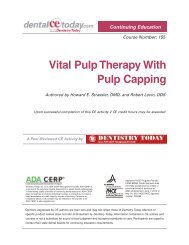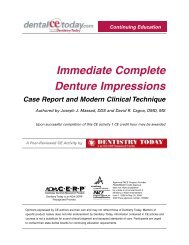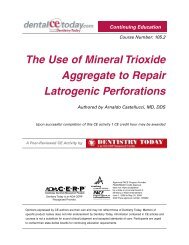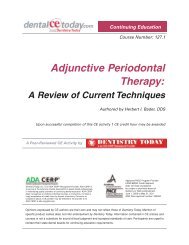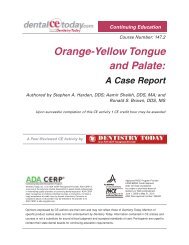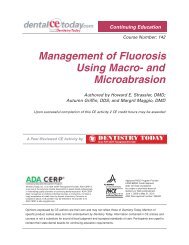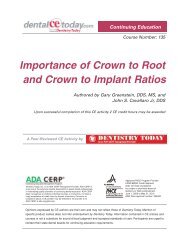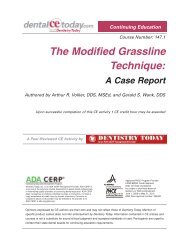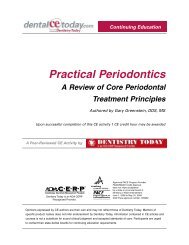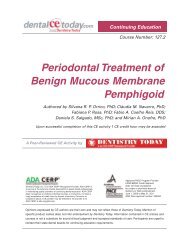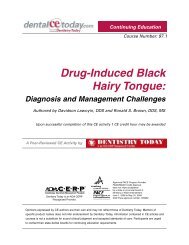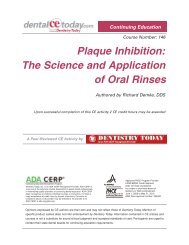Treatment Options for the Edentulous Mandible - DentalCEToday
Treatment Options for the Edentulous Mandible - DentalCEToday
Treatment Options for the Edentulous Mandible - DentalCEToday
You also want an ePaper? Increase the reach of your titles
YUMPU automatically turns print PDFs into web optimized ePapers that Google loves.
Continuing Education<br />
Course Number: 118.2<br />
<strong>Treatment</strong> <strong>Options</strong> <strong>for</strong> <strong>the</strong><br />
<strong>Edentulous</strong> <strong>Mandible</strong><br />
Authored by Steven Kendrick, DDS and David Wong, DDS<br />
Upon successful completion of this CE activity 1 CE credit hour may be awarded<br />
A Peer-Reviewed CE Activity by<br />
Dentistry Today is an ADA CERP<br />
Recognized Provider.<br />
Approved PACE Program Provider<br />
FAGD/MAGD Credit Approval<br />
does not imply acceptance<br />
by a state or provincial board of<br />
dentistry or AGD endorsement.<br />
June 1, 2009 to May 31, 2011<br />
AGD Pace approval number: 309062<br />
Opinions expressed by CE authors are <strong>the</strong>ir own and may not reflect those of Dentistry Today. Mention of<br />
specific product names does not infer endorsement by Dentistry Today. In<strong>for</strong>mation contained in CE articles and<br />
courses is not a substitute <strong>for</strong> sound clinical judgment and accepted standards of care. Participants are urged to<br />
contact <strong>the</strong>ir state dental boards <strong>for</strong> continuing education requirements.
<strong>Treatment</strong> <strong>Options</strong> <strong>for</strong> <strong>the</strong><br />
<strong>Edentulous</strong> <strong>Mandible</strong><br />
Continuing Education<br />
Recommendations <strong>for</strong> Fluoride Varnish Use in Caries Management<br />
options available today <strong>for</strong> <strong>the</strong> edentulous mandible and <strong>the</strong><br />
importance of mandibular anatomy in determining implant<br />
position, pros<strong>the</strong>sis selection, and cantilever length.<br />
LEARNING OBJECTIVES:<br />
After reading this article, <strong>the</strong> individual will learn:<br />
• <strong>Treatment</strong> options available today <strong>for</strong> <strong>the</strong> edentulous<br />
mandible.<br />
• The importance of mandibular anatomy in determining<br />
implant position, pros<strong>the</strong>sis selection, and cantilever<br />
length.<br />
ABOUT THE AUTHORS<br />
Dr. Kendrick is in private practice<br />
in Midwest City, Okla, and is an<br />
instructor at <strong>the</strong> Tulsa Implant Institute.<br />
He can be reached via e-mail at<br />
skend22@hotmail.com.<br />
Disclosure: Dr. Kendrick reports no conflicts of interest.<br />
Dr. Wong is in private practice in Tulsa,<br />
Okla, and is an instructor at <strong>the</strong> Tulsa<br />
Implant Institute. He is a Board Certified<br />
Periodontist and can be reached via e-<br />
mail at david@tulsagums.com.<br />
Disclosure: Dr. Kendrick reports no conflicts of interest.<br />
INTRODUCTION<br />
The treatment of <strong>the</strong> edentulous mandible is one of <strong>the</strong><br />
most challenging to <strong>the</strong> dental practitioner in regards to<br />
patient satisfaction. 1 The number of edentulous arches in<br />
<strong>the</strong> United States is expected to increase. It is estimated<br />
that by <strong>the</strong> year 2020 <strong>the</strong>re will be 61 million edentulous<br />
arches. 2 As this segment of <strong>the</strong> population grows, <strong>the</strong>re will<br />
be an increasing demand on dentistry <strong>for</strong> edentulous<br />
pros<strong>the</strong>tic treatment. This article discusses <strong>the</strong> treatment<br />
ANATOMIC CONSIDERATIONS<br />
The anatomy of <strong>the</strong> edentulous ridge provides challenges<br />
to <strong>the</strong> adaptive process of patients to conventional denture<br />
<strong>the</strong>rapy. One of <strong>the</strong> anatomical considerations is <strong>the</strong><br />
mandibular ridge, which provides less than one quarter <strong>the</strong><br />
support offered by <strong>the</strong> peridontium to <strong>the</strong> natural teeth<br />
(Figure 1). 3 It is from this compromised situation that <strong>the</strong><br />
clinician must build <strong>the</strong> pros<strong>the</strong>sis. An understanding of <strong>the</strong><br />
anatomy of <strong>the</strong> edentulous mandible will allow <strong>the</strong> clinician to<br />
make decisions on implant placement and any ancillary<br />
procedure that will need to be per<strong>for</strong>med in order to obtain a<br />
satisfactory result <strong>for</strong> <strong>the</strong> patient.<br />
The implant retained/supported pros<strong>the</strong>sis will be<br />
affected by <strong>the</strong> location of <strong>the</strong> mental <strong>for</strong>amina and <strong>the</strong><br />
inferior alveolar canal (Figure 2). The distance between<br />
<strong>the</strong>se areas will determine <strong>the</strong> number of possible implant<br />
sites as well as inter-implant spacing. The distance between<br />
<strong>the</strong> <strong>for</strong>amina is variable based on ethnicity, sex, and skull<br />
size. The average inter<strong>for</strong>amen distance <strong>for</strong> African-<br />
American males is 45.8 mm; white males is 45 mm; African-<br />
American females is 43.8 mm; and white females is 41 mm. 4<br />
Figure 1.<br />
The edentulous<br />
mandibular ridge provides<br />
limited support <strong>for</strong> a<br />
conventional pros<strong>the</strong>sis.<br />
Figure 2. The position of <strong>the</strong> mental <strong>for</strong>amina and <strong>the</strong> inferior<br />
alveolar canal will determine <strong>the</strong> space available <strong>for</strong> implant<br />
placement.<br />
1
Continuing Education<br />
<strong>Treatment</strong> <strong>Options</strong> <strong>for</strong> <strong>the</strong> <strong>Edentulous</strong> <strong>Mandible</strong><br />
This space can be divided into 5 equal columns of bone<br />
serving as potential implant sites, labeled A, B, C, D, E,<br />
starting from <strong>the</strong> patient’s right side (Figure 3). If fewer than<br />
5 implants are being placed at <strong>the</strong> initial surgery, <strong>the</strong><br />
implants are placed in different positions depending on <strong>the</strong><br />
type of pros<strong>the</strong>sis being designed, leaving <strong>the</strong> appropriate<br />
columns empty <strong>for</strong> future implant placement should <strong>the</strong><br />
patient want/need additional implant support. 5,6<br />
As a general rule, when 5 implants are placed in <strong>the</strong><br />
anterior mandible between <strong>the</strong> <strong>for</strong>amina, <strong>the</strong> cantilever<br />
should not exceed 2.5 times <strong>the</strong> anteroposterior (A-P)<br />
spread with all o<strong>the</strong>r <strong>for</strong>ce factors being low. 7 The A-P<br />
distance is obtained by connecting a line drawn from <strong>the</strong><br />
distal aspect of <strong>the</strong> most posterior implants and a parallel<br />
line drawn through <strong>the</strong> center of <strong>the</strong> most anterior implant<br />
(Figure 4). The greater <strong>the</strong> A-P distance <strong>the</strong> more favorable<br />
<strong>the</strong> situation <strong>for</strong> <strong>the</strong> posterior cantilever. 8,9<br />
The existing arch <strong>for</strong>m will affect <strong>the</strong> amount of A-P<br />
spread possible. There are 3 types of arch <strong>for</strong>ms: (1) ovoid,<br />
(2) tapering, and (3) square. The square arch <strong>for</strong>m provides<br />
<strong>the</strong> shortest A-P spread, with an A-P dimension often of 2<br />
to 5 mm. Conversely, <strong>the</strong> tapering arch <strong>for</strong>m will result in <strong>the</strong><br />
largest A-P spread, with an A-P distance greater than 8<br />
mm. The ovoid, which is <strong>the</strong> most common, will often have<br />
an A-P distance of 6 to 8 mm. 10 By evaluating <strong>the</strong> arch<br />
<strong>for</strong>m, <strong>the</strong> doctor will have an idea of <strong>the</strong> potential A-P<br />
spread and <strong>the</strong> amount of cantilever possible to support <strong>the</strong><br />
pros<strong>the</strong>sis (Figure 5). Patient <strong>for</strong>ce factors will ultimately<br />
determine <strong>the</strong> amount of cantilever to be used <strong>for</strong> <strong>the</strong><br />
definitive pros<strong>the</strong>sis. 11<br />
The treatment plan will also consider <strong>the</strong> alveolar ridge<br />
height and width. A minimum alveolar height of 9 mm is<br />
recommended if conventional endosseous implants are<br />
expected to be used to ensure predictability. 12 In <strong>the</strong><br />
anterior mandible <strong>the</strong> inferior cortical plate can be<br />
per<strong>for</strong>ated but it is not recommended. Posterior to <strong>the</strong><br />
mental <strong>for</strong>amen a safety zone of 2 mm superior to <strong>the</strong><br />
inferior alveolar canal is suggested. 13 The minimum width of<br />
<strong>the</strong> edentulous mandible is dependent on <strong>the</strong> type of<br />
implant used. A 1 mm thickness of bone buccal and lingual<br />
to <strong>the</strong> implant ensures sufficient bone thickness and blood<br />
supply around <strong>the</strong> implant <strong>for</strong> predictable survival. 14<br />
Figure 3. There are 5 columns of bone available <strong>for</strong> implant<br />
placement between <strong>the</strong> mental <strong>for</strong>amina.<br />
1.5x<br />
x<br />
A-P Spread<br />
Figure 4. Potential<br />
anteroposterior (A-P)<br />
spread based on<br />
implant position.<br />
Figure 5. The square<br />
arch <strong>for</strong>m of this patient<br />
has minimal A-P spread,<br />
leading to a short<br />
cantilever.<br />
The crown height space available will determine <strong>the</strong><br />
type of attachment, material selection, or whe<strong>the</strong>r<br />
additional procedures must be pre<strong>for</strong>med to obtain <strong>the</strong><br />
appropriate space <strong>for</strong> <strong>the</strong> desired pros<strong>the</strong>sis. This<br />
dimension will be <strong>the</strong> least with an implant attachment<br />
retained pros<strong>the</strong>sis (7 mm). The space required <strong>for</strong> <strong>the</strong><br />
current lowest vertical height of an attachment (abutment<br />
plus male) is 3.17 mm on an externally hexed implant, and<br />
2.5 mm on a nonhexed implant.<br />
The bar retained implant overdenture will require 15 to<br />
17 mm of crown height space depending on <strong>the</strong> type of<br />
2
Continuing Education<br />
<strong>Treatment</strong> <strong>Options</strong> <strong>for</strong> <strong>the</strong> <strong>Edentulous</strong> <strong>Mandible</strong><br />
attachment used (Figure 6). When considering an implant<br />
retained fixed pros<strong>the</strong>sis <strong>the</strong> amount of crown height space<br />
present will determine <strong>the</strong> materials to be selected.<br />
The amount of keratinized tissue present will determine<br />
if any soft tissue augmentation procedures will need to be<br />
per<strong>for</strong>med ei<strong>the</strong>r at <strong>the</strong> time of implant placement or in <strong>the</strong><br />
future. Factors such as active/hyperactive gag reflex and<br />
parafunctional habits will also need to be considered.<br />
*<br />
>8 mm Teeth<br />
3 to 5 mm bar + attachment<br />
3 to 5 mm soft tissue<br />
*1 mm space soft tissue to bar<br />
Occlusal Table<br />
15 mm<br />
min<br />
Bone Level<br />
Figure 6. Vertical<br />
space requirements<br />
<strong>for</strong> a bar-retained<br />
overdenture.<br />
PSYCHOLOGIC CONSIDERATIONS<br />
<strong>Edentulous</strong> patients can present with some<br />
psychological challenges related to <strong>the</strong>ir condition. Some<br />
edentulous patients cannot cope with <strong>the</strong>ir pros<strong>the</strong>sis<br />
regardless of how well it is made. 15 This does not mean that<br />
all edentulous patients fall into this category. Just as with<br />
dentate patients, a pre-clinical interview where <strong>the</strong> clinician<br />
and patient can discuss expectations is mutually beneficial.<br />
CONVENTIONAL DENTURE<br />
Conventional denture <strong>the</strong>rapy is also an option <strong>for</strong> <strong>the</strong><br />
patient, but often provides <strong>the</strong> least favorable outcome <strong>for</strong><br />
patients when compared to implant supported pros<strong>the</strong>ses.<br />
Patients report <strong>the</strong> most important qualities of a denture to<br />
be com<strong>for</strong>t, stability, <strong>the</strong> ability to chew and speak normally,<br />
and aes<strong>the</strong>tics. 16,17 Multiple studies have compared<br />
conventional dentures to implant retained overdentures. In<br />
<strong>the</strong>se studies patients had higher satisfaction scores with<br />
implant retained dentures as compared to conventional<br />
dentures. 18<br />
However, <strong>the</strong>re are factors such as financial and/or<br />
health related limitations in which a conventional denture<br />
meets <strong>the</strong> need of that person and should not be<br />
considered inferior treatment.<br />
MINI-IMPLANT RETAINED OVERDENTURE<br />
A mini-implant retained mandibular denture should be<br />
considered as a treatment option when <strong>the</strong>re is insufficient<br />
buccal-lingual width of <strong>the</strong> alveolar ridge <strong>for</strong> standard size<br />
endosseous implants and <strong>the</strong> patient cannot undergo<br />
grafting procedures, whe<strong>the</strong>r due to financial or health risk<br />
Figure 7. Miniimplant<br />
placement<br />
in an atrophic<br />
mandibular ridge.<br />
factors (Figure 7). There will also be a percentage of<br />
patients who will not consent to <strong>the</strong> grafting procedure due<br />
to a perceived negative risk/benefit ratio. Current miniimplants<br />
on <strong>the</strong> market range from 1.8 to 3.0 mm in<br />
diameter and length ranging from 10 to 18 mm. The number<br />
of implants recommended in <strong>the</strong> mandible is a minimum of<br />
4 with a spacing of 5 to 8 mm between implants. The<br />
manufacturers also recommend a minimum distance of 7 mm<br />
anterior to <strong>the</strong> mental <strong>for</strong>amina. The total number of<br />
implants possible will be determined by <strong>the</strong> distance<br />
between <strong>the</strong> mental <strong>for</strong>amina. Immediate loading of <strong>the</strong><br />
implants is recommended only when <strong>the</strong> implants are able<br />
to resist 30 to 35 ncm of load (as per manufacturer’s<br />
instruction). At that time <strong>the</strong> mandibular denture is<br />
connected to <strong>the</strong> mini-implants using a chairside pick-up<br />
technique, or an impression is taken and a laboratory reline<br />
process is per<strong>for</strong>med.<br />
ATTACHMENT-RETAINED IMPLANT OVERDENTURE<br />
Implant overdentures can be supported by as many as<br />
5 implants in <strong>the</strong> anterior mandible, to as few as one implant<br />
(Figures 8 to 10). 19 The McGill Consensus Statement on<br />
Overdentures stated that <strong>the</strong> mandibular 2-implant<br />
overdenture is <strong>the</strong> minimum standard of care <strong>for</strong> edentulous<br />
patients. 20 This is where <strong>the</strong> treatment plan discussion with<br />
3
Continuing Education<br />
<strong>Treatment</strong> <strong>Options</strong> <strong>for</strong> <strong>the</strong> <strong>Edentulous</strong> <strong>Mandible</strong><br />
<strong>the</strong> patient should begin. The patient’s desires <strong>for</strong> stability<br />
and <strong>the</strong> ability to remove or not remove <strong>the</strong> pros<strong>the</strong>sis will<br />
determine <strong>the</strong> final number of implants and type of<br />
pros<strong>the</strong>sis. An attachment-retained overdenture will require<br />
implants in different positions depending on <strong>the</strong> amount of<br />
retention and stability required by <strong>the</strong> patient. A 2-implantretained<br />
overdenture will have implants placed in <strong>the</strong> B-D<br />
positions. This provides an anterior stop and minimizes<br />
anterior-posterior rocking. A patient requiring more stability<br />
will have implants placed in <strong>the</strong> A-C-E position. This will<br />
increase retention with an additional implant and will create<br />
a tripod effect to fur<strong>the</strong>r minimize anterior-posterior rocking.<br />
The patient requiring more stability and who is transitioning<br />
to a fixed pros<strong>the</strong>sis in <strong>the</strong> future or cannot af<strong>for</strong>d <strong>the</strong><br />
expense of a bar-retained overdenture will have <strong>the</strong><br />
treatment option of a 4-implant-retained pros<strong>the</strong>sis with<br />
implants in <strong>the</strong> A-B-D-E positions.<br />
The attachment-retained overdenture has <strong>the</strong> main<br />
advantage of cost over <strong>the</strong> bar-retained implant overdenture<br />
and <strong>the</strong> implant retained fixed pros<strong>the</strong>sis. 21,22 However, it does<br />
not address posterior bone loss and will have less stability than<br />
a bar-retained overdenture or a fixed pros<strong>the</strong>sis. 23<br />
BAR-RETAINED IMPLANT OVERDENTURE<br />
The bar-retained implant overdenture provides more<br />
support <strong>for</strong> <strong>the</strong> edentulous patient compared to <strong>the</strong><br />
attachment-retained implant denture. The same implant<br />
placement options are available but <strong>the</strong> ability exists to<br />
cantilever <strong>the</strong> bar posteriorly due to A-P spread (Figure 11).<br />
The B-D, A-C-E, and B-C-D options are generally not<br />
cantilevered due to <strong>the</strong> limited implant support and short A-<br />
P distances. The A-B-D-E option in a tapering arch is often<br />
10 mm, and 8 mm in an ovoid arch. If all o<strong>the</strong>r factors are<br />
favorable this would allow a cantilever in <strong>the</strong> ovoid arch of<br />
up to 12 mm, and up to 15 mm in <strong>the</strong> tapering arch. The<br />
square arch <strong>for</strong>m would only allow 4 mm of cantilever. 24<br />
If <strong>the</strong> patient requires more support an additional<br />
implant can be placed in <strong>the</strong> C position, which will increase<br />
<strong>the</strong> A-P distance in an ovoid or tapering arch. An implant<br />
can also be placed in <strong>the</strong> molar region on ei<strong>the</strong>r side to<br />
increase <strong>the</strong> A-P distance. This is a primary option <strong>for</strong><br />
increasing A-P spread in a square arch from.<br />
8<br />
10<br />
Figure 8, 9 and 10. Attachment-retained implant overdenture<br />
with implants in <strong>the</strong> AB DE position.<br />
15 mm<br />
Figure 11.<br />
Bar-retained<br />
overdenture with an<br />
implant in <strong>the</strong> left first<br />
molar position to<br />
increase <strong>the</strong> A-P<br />
spread.<br />
Figure 12.<br />
The distance from <strong>the</strong><br />
implant plat<strong>for</strong>m to <strong>the</strong><br />
occlusal table is less<br />
than 15 mm; <strong>the</strong><br />
pros<strong>the</strong>tic material<br />
indicated is PFM.<br />
Figure 13.<br />
The distance from <strong>the</strong><br />
implant plat<strong>for</strong>m to <strong>the</strong><br />
occlusal table is greater<br />
than 15 mm; <strong>the</strong> hybrid<br />
pros<strong>the</strong>sis is <strong>the</strong><br />
indicated restoration.<br />
4
Continuing Education<br />
<strong>Treatment</strong> <strong>Options</strong> <strong>for</strong> <strong>the</strong> <strong>Edentulous</strong> <strong>Mandible</strong><br />
IMPLANT-RETAINED FIXED PROSTHESIS<br />
Patient desires will also dictate <strong>the</strong> fabrication of an<br />
implant-retained fixed pros<strong>the</strong>sis. The 5 columns of bone<br />
are still available to be used, with <strong>the</strong> option of placing<br />
implants above or behind <strong>the</strong> mental <strong>for</strong>amina to reduce<br />
cantilever lengths.<br />
This pros<strong>the</strong>sis also has <strong>the</strong> potential of an increase of<br />
posterior bone height. 25,26 One to 4 additional implants can<br />
be placed in <strong>the</strong> mandible after <strong>the</strong> A-B-D-E positions have<br />
been filled to gain <strong>the</strong> maximum A-P distance and increase<br />
implant support.<br />
Fur<strong>the</strong>r, crown height space will play a role in material<br />
selection <strong>for</strong> <strong>the</strong> pros<strong>the</strong>sis. If <strong>the</strong> distance from <strong>the</strong> implant<br />
plat<strong>for</strong>m to <strong>the</strong> occlusal table is less than 15 mm, <strong>the</strong>n <strong>the</strong><br />
pros<strong>the</strong>tic material indicated is PMF (Figure 12). If <strong>the</strong><br />
distance is greater than 15 mm, <strong>the</strong>n a hybrid pros<strong>the</strong>sis<br />
should be used (Figure 13). 27 The distance of 15 mm is<br />
important because of <strong>the</strong> physical properties of <strong>the</strong><br />
restorative materials. Acrylic is a material that requires bulk<br />
<strong>for</strong> strength. If <strong>the</strong>re is less than 15 mm of distance from <strong>the</strong><br />
implant plat<strong>for</strong>m to <strong>the</strong> occlusal table <strong>the</strong>re will not be<br />
sufficient space to achieve <strong>the</strong> bulk of acrylic necessary to<br />
provide strength <strong>for</strong> <strong>the</strong> pros<strong>the</strong>sis.<br />
Likewise, PFM restorations have difficulties when too<br />
much space is available. At dimensions greater than 15 mm<br />
from <strong>the</strong> implant plat<strong>for</strong>m to <strong>the</strong> occlusal table, <strong>the</strong> control<br />
of surface porosity across <strong>the</strong> metal substructure becomes<br />
difficult due to variations in cooling and heating rates across<br />
<strong>the</strong> metal. 28 Because of this it becomes difficult to bake<br />
porcelain to <strong>the</strong> substructure. The result is <strong>the</strong> high<br />
possibility of future porcelain fracture. 29<br />
CONCLUSION<br />
An understanding of <strong>the</strong> anatomy of <strong>the</strong> mandible along<br />
with an understanding of <strong>the</strong> concept of A-P spread will<br />
allow <strong>the</strong> clinician to treatment plan patients with an<br />
edentulous mandible. <strong>Treatment</strong> options should be based<br />
on <strong>the</strong> patient’s wants/desires <strong>for</strong> <strong>the</strong> final pros<strong>the</strong>sis. The<br />
2-implant overdenture should be <strong>the</strong> starting point <strong>for</strong><br />
treatment options, not <strong>the</strong> end point. If <strong>the</strong> patient is unable<br />
or unwilling to undergo grafting procedures, <strong>the</strong>n <strong>the</strong> miniimplant<br />
option should be discussed, but it should not be<br />
seen as a treatment <strong>for</strong> every edentulous patient. The<br />
patient will ultimately make <strong>the</strong> decision based on what<br />
treatment option is in <strong>the</strong>ir best interest at that given point<br />
in <strong>the</strong>ir life. By understanding what is necessary to provide<br />
each of <strong>the</strong> treatment options discussed in this article, <strong>the</strong><br />
clinician can <strong>for</strong>mulate a plan to phase treatment <strong>for</strong> <strong>the</strong><br />
patient and help <strong>the</strong>m arrive at <strong>the</strong>ir ultimate goal once <strong>the</strong>y<br />
have been in<strong>for</strong>med of <strong>the</strong> pros/cons and consequences of<br />
no treatment.<br />
REFERENCES<br />
1. Zarb GA, ed. Osseointegration: On Continuing Synergies in<br />
Surgery, Prosthodontics, Biomaterials. Chicago, Ill:<br />
Quintessence Publishing Co; 2008:4-13.<br />
2. Douglass CW, Shih A, Ostry L. Will <strong>the</strong>re be a need <strong>for</strong><br />
complete dentures in <strong>the</strong> United States in 2020 J Pros<strong>the</strong>t<br />
Dent. 2002;87:5-8.<br />
3. Zarb GA, Bolender CL, Eckert SE, et al (eds). Prosthodontic<br />
<strong>Treatment</strong> <strong>for</strong> <strong>Edentulous</strong> Patients: Complete Dentures and<br />
Implant-Supported Pros<strong>the</strong>ses. St. Louis, Mo: Mosby; 2004:3-7.<br />
4. Cutright B, Quillopa N, Schubert W. An anthropometric<br />
analysis of <strong>the</strong> key <strong>for</strong>amina <strong>for</strong> maxillofacial surgery. J Oral<br />
Maxillofac Surg. 2003;61:354-347.<br />
5. Misch CE. Implant overdentures relieve discom<strong>for</strong>t <strong>for</strong> <strong>the</strong><br />
edentulous patient. Dentist. 1989;67:37-38.<br />
6. Misch CE. Mandibular overdenture treatment options. In:<br />
Misch Implant Institute Manual. Dearborn, Mich: Misch<br />
International Implant Institute; 1984:29-37.<br />
7. Misch CE. Preimplant Prosthodontics. In: Dental Implant<br />
Pros<strong>the</strong>tics. St. Louis, Mo: Mosby; 2005:178.<br />
8. Brosky ME, Korioth TW, Hodges J. The anterior cantilever in<br />
<strong>the</strong> implant-supported screw-retained mandibular pros<strong>the</strong>sis.<br />
J Pros<strong>the</strong>t Dent. 2003;89:244-249.<br />
9. Misch CE. The endentulous mandible: an organized approach<br />
to implant-supported overdentures. In: Contemporary Implant<br />
Dentistry. 3rd ed. St. Louis, Mo: Mosby; 2008:309.<br />
10. Misch CE. The endentulous mandible: an organized approach<br />
to implant-supported overdentures. In: Contemporary Implant<br />
Dentistry. 3rd ed. St. Louis, Mo: Mosby; 2008:308-309.<br />
11. Misch CE. Preimplant prosthodontics: overall evaluation.<br />
Specific criteria. and pretreatment Pro<strong>the</strong>ses. In:<br />
Contemporary Implant Dentistry. 3rd ed. St. Louis, Mo: Mosby;<br />
2008:254.<br />
12. Goodacre CJ, Bernal G, Rungcharassaeng K, et al. Clinical<br />
complications with implants and implant pros<strong>the</strong>ses.<br />
J Pros<strong>the</strong>t Dent. 2003;90:121-132.<br />
5
Continuing Education<br />
<strong>Treatment</strong> <strong>Options</strong> <strong>for</strong> <strong>the</strong> <strong>Edentulous</strong> <strong>Mandible</strong><br />
13. Misch CE. Root <strong>for</strong>m surgery in <strong>the</strong> edentulous and posterior<br />
mandible: implant insertion. In: Contemporary Implant<br />
Dentistry. 3rd ed. St. Louis, Mo: Mosby; 2008:701.<br />
14. Misch CE. Available bone and implant dentistry. In: Dental<br />
Implant Pros<strong>the</strong>tics. St. Louis, Mo: Mosby; 2005:108.<br />
15. Zarb GA, Bolender CL, Eckert SE, et al (eds). Prosthodontic<br />
<strong>Treatment</strong> <strong>for</strong> <strong>Edentulous</strong> Patients: Complete Dentures and<br />
Implant-Supported Pros<strong>the</strong>ses. St. Louis, Mo: Mosby; 2004:3-7.<br />
16. Berg E. The influence of some anamnestic, demographic, and<br />
clinical variables on patient acceptance of new complete<br />
dentures. Acta Odontol Scand. 1984;42:119-127.<br />
17. Kent G. Effects of osseointegrated implants on psychological<br />
and social well-being: a literature review. J Pros<strong>the</strong>t Dent.<br />
1992;68:515-518.<br />
18. Awad MA, Feine JS. Measuring patient satisfaction with<br />
mandibular pros<strong>the</strong>ses. Community Dent Oral Epidemiol.<br />
1998;26:400-405.<br />
19. Krennmair G, Ulm C. The symphyseal single-tooth implant <strong>for</strong><br />
anchorage of a mandibular complete denture in geriatric<br />
patients: a clinical report. Int J Oral Maxillofac Implants.<br />
2001;16:98-104.<br />
20. Feine JS, Carlsson GE, Awad MA, et al. The McGill<br />
consensus statement on overdentures. Mandibular twoimplant<br />
overdentures as first choice standard of care <strong>for</strong><br />
edentulous patients. Montreal, Quebec, May 24-25, 2002.<br />
Int J Oral Maxillofac Implants. 2002;17:601-602.<br />
21. Carlsson GE, Kronström M, de Baat C, et al. A survey of<br />
<strong>the</strong> use of mandibular implant overdentures in 10 countries.<br />
Int J Prosthodont. 2004;17:211-217.<br />
22. Palmqvist S, Owall B, Schou S. A prospective randomized<br />
clinical study comparing implant-supported fixed pros<strong>the</strong>ses<br />
and overdentures in <strong>the</strong> edentulous mandible: prosthodontic<br />
production time and costs. Int J Prosthodont. 2004;17:231-235.<br />
23. Misch CE. The endentulous mandible: an organized approach<br />
to implant-supported overdentures. In: Contemporary Implant<br />
Dentistry. 3rd ed. St. Louis, Mo: Mosby; 2008:294.<br />
24. Misch CE. The endentulous mandible: an organized approach<br />
to implant-supported overdentures. In: Contemporary Implant<br />
Dentistry. 3rd ed. St Louis, Mo: Mosby; 2008:307.<br />
25. Wright PS, Watson RM. Effect of prefabricated bar design with<br />
implant-stabilized pros<strong>the</strong>ses on ridge resorption: a clinical<br />
report. Int J Oral and Maxillofac Implants. 1998;13:77-81.<br />
26. Misch CE. The endentulous mandible: an organized approach<br />
to implant-supported overdentures. In: Contemporary Implant<br />
Dentistry. 3rd ed. St. Louis, Mo: Mosby; 2008:291.<br />
27. Reddy MS, Geurs NC, Wang IC, et al. Mandibular growth<br />
following implant restoration: does Wolff’s law apply to<br />
residual ridge resorption Int J Periodontics Restorative Dent.<br />
2002;22:315-321.<br />
28. Bridger DV, Nicholls JI. Distortion of ceramometal fixed partial<br />
dentures during <strong>the</strong> firing cycle. J Pros<strong>the</strong>t Dent. 1981;45:507-514.<br />
29. Bertolotti RL, Moffa JP. Creep rate of porcelain-bonding alloys<br />
as a function of temperature. J Dent Res. 1980;59:2062-2065.<br />
6
Continuing Education<br />
<strong>Treatment</strong> <strong>Options</strong> <strong>for</strong> <strong>the</strong> <strong>Edentulous</strong> <strong>Mandible</strong><br />
POST EXAMINATION INFORMATION<br />
To receive continuing education credit <strong>for</strong> participation in<br />
this educational activity you must complete <strong>the</strong> program<br />
post examination and receive a score of 70% or better.<br />
Traditional Completion Option:<br />
You may fax or mail your answers with payment to Dentistry<br />
Today (see Traditional Completion In<strong>for</strong>mation on following<br />
page). All in<strong>for</strong>mation requested must be provided in order<br />
to process <strong>the</strong> program <strong>for</strong> credit. Be sure to complete your<br />
“Payment”, “Personal Certification In<strong>for</strong>mation”, “Answers”<br />
and “Evaluation” <strong>for</strong>ms, Your exam will be graded within 72<br />
hours of receipt. Upon successful completion of <strong>the</strong> postexam<br />
(70% or higher), a “letter of completion” will be mailed<br />
to <strong>the</strong> address provided.<br />
Online Completion Option:<br />
Use this page to review <strong>the</strong> questions and mark your<br />
answers. Return to dentalCEtoday.com and signin. If you<br />
have not previously purchased <strong>the</strong> program select it from<br />
<strong>the</strong> “Online Courses” listing and complete <strong>the</strong> online<br />
purchase process. Once purchased <strong>the</strong> program will be<br />
added to your User History page where a Take Exam link<br />
will be provided directly across from <strong>the</strong> program title.<br />
Select <strong>the</strong> Take Exam link, complete all <strong>the</strong> program<br />
questions and Submit your answers. An immediate grade<br />
report will be provided. Upon receiving a passing grade<br />
complete <strong>the</strong> online evaluation <strong>for</strong>m. Upon submitting <strong>the</strong><br />
<strong>for</strong>m your Letter Of Completion will be provided<br />
immediately <strong>for</strong> printing.<br />
General Program In<strong>for</strong>mation:<br />
Online users may login to dentalCEtoday.com anytime in<br />
<strong>the</strong> future to access previously purchased programs and<br />
view or print “letters of completion” and results.<br />
POST EXAMINATION QUESTIONS<br />
1. The edentulous mandibular ridge provides less than<br />
_______ <strong>the</strong> support offered by <strong>the</strong> peridontium to <strong>the</strong><br />
natural teeth.<br />
a. one third c. one half<br />
b. one fifth d. one quarter<br />
2. The implant retained/supported pros<strong>the</strong>sis will be<br />
affected by <strong>the</strong> anatomic location of <strong>the</strong> ____________<br />
and <strong>the</strong> ____________.<br />
a. mental <strong>for</strong>amina; inferior alveolar canal<br />
b. hyoglossis; inferior alveolar canal<br />
c. mental <strong>for</strong>amina; hyoid bone<br />
d. hyoglossis; hyoid bone<br />
3. The anteroposterior distance is obtained by<br />
connecting a line drawn from <strong>the</strong> ________ aspect of<br />
<strong>the</strong> most ________ implants and a parallel line drawn<br />
through <strong>the</strong> center of <strong>the</strong> most anterior implant.<br />
a. distal; posterior c. distal; anterior<br />
b. mesial; posterior d. mesial; anterior.<br />
4. The _______ arch <strong>for</strong>m provides <strong>the</strong> shortest A-P<br />
spread with an A-P dimension often of ________ mm.<br />
a. ovoid; 8 to 9 c. tapered; 1 to 2<br />
b. square; 2 to 5 d. square; 8 to 9<br />
5. What is <strong>the</strong> minimum distance required <strong>for</strong> an implant<br />
attachment retained overdenture, measured from <strong>the</strong><br />
alveolar crest to <strong>the</strong> inner aspect of <strong>the</strong> lingual<br />
denture base?<br />
a. 5 mm c. 7 mm<br />
b. 6 mm d. 8 mm<br />
6. The vertical component of <strong>the</strong> bar retained overdenture<br />
requires at least ________ of crown height space.<br />
a. 10 to 12 mm c. 15 to 17 mm<br />
b. 13 to 15 mm d. 18 to 20 mm<br />
7. If <strong>the</strong> distance from <strong>the</strong> implant plat<strong>for</strong>m to <strong>the</strong><br />
occlusal table is less than 15 mm, <strong>the</strong>n <strong>the</strong> pros<strong>the</strong>tic<br />
material indicated <strong>for</strong> a fixed pros<strong>the</strong>sis is:<br />
a. PFM. c. composite resin.<br />
b. acrylic-pressed-to-metal. d. all metal.<br />
8. The attachment-retained overdenture has <strong>the</strong><br />
advantage of cost compared to <strong>the</strong> bar-retained<br />
implant overdenture. However, <strong>the</strong> <strong>for</strong>mer has less<br />
stability than <strong>the</strong> latter.<br />
a. The first statement is true, <strong>the</strong> second is false<br />
b. The first statement is false, <strong>the</strong> second is true<br />
c. Both statements are true<br />
d. Both statements are false<br />
7
Continuing Education<br />
<strong>Treatment</strong> <strong>Options</strong> <strong>for</strong> <strong>the</strong> <strong>Edentulous</strong> <strong>Mandible</strong><br />
PROGRAM COMPLETION INFORMATION<br />
PERSONAL CERTIFICATION INFORMATION:<br />
If you wish to purchase and complete this activity<br />
traditionally (mail or fax) ra<strong>the</strong>r than Online, you must<br />
provide <strong>the</strong> in<strong>for</strong>mation requested below. Please be sure to<br />
select your answers carefully and complete <strong>the</strong> evaluation<br />
in<strong>for</strong>mation. To receive credit you must answer at least six<br />
of <strong>the</strong> eight questions correctly.<br />
Complete online at: www.dentalcetoday.com<br />
Last Name (PLEASE PRINT CLEARLY OR TYPE)<br />
First Name<br />
Profession / Credentials<br />
Street Address<br />
License Number<br />
TRADITIONAL COMPLETION INFORMATION:<br />
Suite or Apartment Number<br />
Mail or Fax this completed <strong>for</strong>m with payment to:<br />
Dentistry Today<br />
Department of Continuing Education<br />
100 Passaic Avenue<br />
Fairfield, NJ 07004<br />
Fax: 973-882-3662<br />
City State Zip Code<br />
Daytime Telephone Number With Area Code<br />
Fax Number With Area Code<br />
E-mail Address<br />
PAYMENT & CREDIT INFORMATION:<br />
Examination Fee: $20.00 Credit Hours: 1.0<br />
Note: There is a $10 surcharge to process a check drawn on<br />
any bank o<strong>the</strong>r than a US bank. Should you have additional<br />
questions, please contact us at (973) 882-4700.<br />
❏ I have enclosed a check or money order.<br />
❏ I am using a credit card.<br />
My Credit Card in<strong>for</strong>mation is provided below.<br />
❏ American Express ❏ Visa ❏ MC ❏ Discover<br />
ANSWER FORM: COURSE #: 118.2<br />
Please check <strong>the</strong> correct box <strong>for</strong> each question below.<br />
1. ❏ a ❏ b ❏ c ❏ d 5. ❏ a ❏ b ❏ c ❏ d<br />
2. ❏ a ❏ b ❏ c ❏ d 6. ❏ a ❏ b ❏ c ❏ d<br />
3. ❏ a ❏ b ❏ c ❏ d 7. ❏ a ❏ b ❏ c ❏ d<br />
4. ❏ a ❏ b ❏ c ❏ d 8. ❏ a ❏ b ❏ c ❏ d<br />
Please provide <strong>the</strong> following (please print clearly):<br />
Exact Name on Credit Card<br />
Credit Card #<br />
Signature<br />
Dentistry Today is an ADA CERP<br />
Recognized Provider.<br />
/<br />
Expiration Date<br />
Approved PACE Program Provider<br />
FAGD/MAGD Credit Approval<br />
does not imply acceptance<br />
by a state or provincial board of<br />
dentistry or AGD endorsement.<br />
June 1, 2009 to May 31, 2011<br />
AGD Pace approval number: 309062<br />
PROGRAM EVAUATION FORM<br />
Please complete <strong>the</strong> following activity evaluation questions.<br />
Rating Scale: Excellent = 5 and Poor = 0<br />
Course objectives were achieved.<br />
Content was useful and benefited your<br />
clinical practice.<br />
Review questions were clear and relevant<br />
to <strong>the</strong> editorial.<br />
Illustrations and photographs were<br />
clear and relevant.<br />
Written presentation was in<strong>for</strong>mative<br />
and concise.<br />
How much time did you spend reading<br />
<strong>the</strong> activity & completing <strong>the</strong> test?



